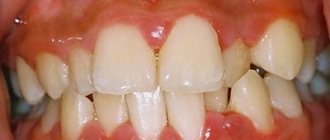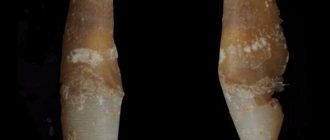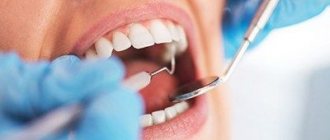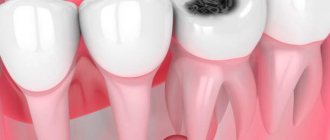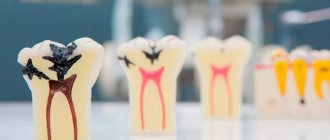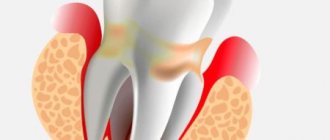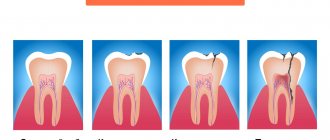If caries is not treated in time, serious complications can develop. Periodontitis is one of the most common. This is an inflammation of the connective tissue surrounding the root of the tooth. It is accompanied by acute toothache that cannot be tolerated. Symptoms also include bad breath, mobility of teeth, swelling of the gums, and a cyst at the apex of the root. The disease must be quickly eliminated, otherwise you may lose the tooth.
Does your tooth hurt for a long time after periodontitis treatment? Find out what this might be related to. We tell you in what cases you need the help of a specialist and where to go in Moscow.
Types of chronic periodontitis
Studies of the clinical picture of the possible course of chronic periodontitis and morphological signs made it possible to identify the following types:
- Granulating
With this form of the disease, under a microscope, a noticeable thickening can be observed in the apical part of the tooth root. There is a change in the surface of the periodontium, it becomes uneven. Over time, granulation tissue grows, which causes resorption of bone tissue in the area of inflammation. This process is often accompanied by the appearance of purulent foci, which provokes the appearance of fistulas. In some cases, soft tissue adjacent to the site of inflammation undergoes granulation. This causes the formation of granulomas of various types (submucosal, subperiosteal, subcutaneous), after opening which, fistulas appear on the face and oral cavity, and unaesthetic scars appear at the site of their healing.
Patients experiencing granulating inflammation report pain when chewing solid food, aggravated by pressure, as well as periodic exacerbations of painful conditions.
- Granulomatous
One of the forms of periapical inflammation, characterized by the formation of granulation tissue in the area of the root apex. The maturation of this tissue along the periphery provokes the appearance of a fibrous capsule that degenerates into a granuloma. Depending on the structural features, simple, epithelial and cystic granulomas are distinguished. Quite often, this form of the disease occurs as a consequence of granulating inflammation.
The course of the disease can occur according to various scenarios. Sometimes the granuloma grows slowly or does not grow at all. In this case, it usually does not cause any discomfort and is discovered by chance during an X-ray examination.
In other patients, the granuloma may enlarge, most often coinciding with exacerbations of chronic periodontitis, provoking changes in the granuloma tissue.
- Fibrous
It is characterized by the formation of a limited focus of inflammation caused by the spread of fibrous tissue. Most often this occurs after treatment of the forms of periodontitis described above, but sometimes the fibrous form occurs independently.
Often, fibrous inflammation is accompanied by excessive formation of cement, and in some cases, sclerosis of adjacent bone tissue.
An X-ray examination allows you to determine the form of chronic periodontitis. It is very important to correctly differentiate different types of disease, since the effectiveness of treatment directly depends on this.
What not to do?
If, after treatment, a tooth hurts when pressed or without mechanical action, you should under no circumstances resort to folk remedies such as heating, hot compresses, heating pads - if there is an inflammatory process, this can greatly worsen the condition. In case of allergic reactions, heat will also increase swelling.
It is also not recommended to use folk remedies for rinsing, which can cause a burn to the mucous membrane - iodine, tinctures of alcohol or vodka, liquids with the juice of “scorching” plants, etc. Even if there is no gum damage, such measures can worsen the situation.
It is also not worth taking various painkillers uncontrollably - firstly, you need to see a doctor in any case, and the effect of analgesics will not allow you to fully evaluate the clinical picture. Secondly, it can be dangerous to health.
It is important to visit a doctor at the first opportunity and perform all the necessary procedures to eliminate unpleasant consequences and improve the condition.
Causes of chronic periodontitis
In the vast majority of cases, the cause of chronic periodontal inflammation is untreated acute pulpitis. And it, in turn, arises from neglected caries. It is not difficult to guess that the root of all troubles and complications lies precisely in carious spots, which patients tend to ignore.
It is interesting that, unlike most other diseases, periodontitis does not always have an acute stage; in some cases, pulpitis immediately turns into a chronic form of periodontal inflammation, which, without showing itself for a long time, has a destructive effect on the teeth and gums.
Quite often, the chronic stage is still preceded by an acute period of the disease, but many tend to delay treatment, preferring to relieve the pain with medication. As a result, the tooth stops hurting and the patient calms down, but meanwhile the inflammatory process gains momentum, so that later it can express itself fully.
If you do not want to become a victim of chronic periodontitis, then go for a consultation with a dentist as soon as you notice one of the following signs:
- pain that appears when chewing and biting hard foods, as well as pain of a periodic or pulsating nature;
- a feeling of a tooth protruding, preventing you from closing your jaw;
- swelling of the gums and irritation of the oral mucosa in the area of the diseased tooth;
- tooth mobility caused by periodontal destruction;
- the occurrence of one or more fistulas;
- inflammation of the submandibular lymph nodes, observed from the side of the inflammation.
Do not delay visiting your doctor, even if the symptoms are mild.
How does this pathology manifest itself?
Acute periodontitis is characterized by:
- sharp pain when biting on a tooth;
- feeling as if it has shifted;
- swelling of the soft tissues of the gums;
- increase in body temperature.
In the chronic form of dental periodontitis, the following symptoms are characteristic:
- wave-like appearance and disappearance of pain;
- increased tooth sensitivity when biting;
- periodic formation of a fistulous tract in the gum tissue with the appearance of purulent discharge.
Basic principles of treatment of chronic periodontitis
The choice of treatment methods and means depends on what form of the disease is diagnosed. They can be either conservative or surgical.
The first stage of treatment will be tooth sanitation. During the procedure, the doctor thoroughly cleans the dental canals and tooth cavity, ridding them of carious lesions and infected tissues. Then all cleaned cavities are treated with special antiseptic preparations, and after the doctor is convinced that the inflammatory process has stopped, a permanent filling is placed.
In advanced and complex situations, surgical treatment may be recommended. There is no need to be afraid of this, since doctors always strive to save the tooth by removing only the infected tissue. If therapy is powerless, then resection of the root apex, tooth replantation, cystotomy or cystectomy can be performed. In this case, an effective, but most gentle method is always chosen, which allows you to achieve the desired result while minimizing unpleasant sensations for the patient. Tooth extraction, as a surgical method, is used only in the most extreme cases.
Root perforation
Perforation is the creation of an artificial root hole. As a rule, in this case, the pain is sharp, unbearable and makes itself felt immediately after the anesthetic stops working. This can happen during instrumental processing of canals - preparing them for filling.
As in most other cases, the structure of the root system plays an important role here. Narrow, curved canals are a common cause of perforation. In this case, the tool does not move along the canal, but into the root wall.
If a tooth hurts for this reason after treatment of pulpitis, the symptom may be accompanied by bleeding. In addition, some patients report pain even with current anesthesia - subjectively it is perceived as the feeling of an injection into the gums. If the tooth was filled after perforation, the filling material may leak beyond the root. Severe pain persists for up to 3 weeks, and the main complication of this phenomenon is the inflammatory process.
Exacerbation of periodontitis: symptoms and treatment
Most often, chronic periodontitis is detected during exacerbations. It is even often initially mistaken for an acute form, but additional signs revealed by studying x-rays and the patient’s condition make it possible to establish an accurate diagnosis.
The main symptoms of exacerbation of chronic periodontitis are in many ways similar to those observed in the acute form of the disease, and the treatment regimen in both of these cases is the same. It is carried out in several stages.
At the first visit, the doctor opens the pulp chamber and removes the nerve, after which he thoroughly cleans the canals and cavity of the tooth, creating conditions for the outflow of pus. After this, the exposed tooth must be rinsed for several days with a soda solution in order to wash out the remaining purulent masses.
During the second visit, medications are placed into the canals and the cavity of the tooth, which are closed with a temporary filling. The aching tooth is left in this state for 1-2 weeks.
After this, if the control image does not cause alarm, the temporary filling is replaced with a permanent one.
In some cases, exacerbation of chronic periodontitis makes itself felt after completion of treatment. To relieve its symptoms, anti-inflammatory therapy is prescribed, which can be supplemented with physiotherapeutic procedures.
Why is chronic periodontitis dangerous?
The anatomical structure of the teeth ensures in most cases the free outflow of serous and purulent masses from the source of inflammation. As a result, the patient may not be aware of the presence of chronic periodontal inflammation for a long time. All this time it is actively developing, exposing tissues to destruction. Sometimes this leads to the fact that it is no longer possible to save the tooth.
In addition to tooth loss, chronic periodontitis leads to the formation of skin or gingival fistulas and various types of granulomas, which require long-term (several months) complex and expensive treatment.
Granulomatous formations pose an additional danger. They can, under the influence of such unfavorable factors as stress or hypothermia, lead to the development of serious inflammatory processes, including sepsis.
Chronic periodontal inflammation can also accelerate the progression of diseases such as nephritis, arthritis and rheumatism, and provoke other health problems.
Removing the filling material beyond the root apex
If, after treatment of pulpitis, the tooth hurts when pressed, perhaps we are talking about the removal of the filling material beyond the root of the tooth, into the adjacent tissues. The intensity of the sensation depends on how much material has gone beyond the apex of the root. Despite the fact that today a doctor has ample opportunities to control the accuracy of canal filling, as well as the use of high-quality materials, this can happen. It is worth noting that X-ray monitoring of treatment is intended to prevent the development of such a consequence - after the filling is completed, an image should be taken in which, in the event of a re-filling, the doctor will be able to notice excess material and choose the tactics for further action. Re-filling or removal of filling material beyond the root apex in itself does not pose a particular threat.
The exit of the filling material beyond the root apex can cause long-term pain immediately after the anesthetic wears off and persists for a long time - up to several months. This is a natural reaction of tissues to foreign material. Removal of material may be due to the following reasons:
- difficulties in determining the length of channels;
- incorrect selection of a pin from materials for the canal;
- lack of apical stop, etc.
However, this is not the only possible treatment difficulty that provokes pain.
Prevention of periodontal inflammation
In order not to encounter chronic periodontitis, avoid complications of dental diseases such as pulpitis and caries. Treatment of caries in all cases is much simpler and faster, and it costs much less than the fight against inflammatory processes in the periodontium.
Remember that regular visits to the dentist once every six months can keep your teeth healthy and protect you from large financial expenses in the future.
In addition, strictly observe oral hygiene, using only high-quality toothpastes to brush your teeth, for example, ASEPTA SENSITIVE, which is specially designed to prevent inflammation of the teeth and gums, as well as provide gentle care for sensitive enamel. The carefully selected ratio of enzymes, thermal mud and herbs in its composition ensures maximum therapeutic and prophylactic effect.
ASEPTA mouthwash will also provide invaluable assistance in creating a healthy microflora that prevents the occurrence of periodontitis. Its regular use can significantly reduce the number of pathogenic microorganisms in the mouth, which most often cause infectious inflammatory processes.
Preventive measures also include a healthy diet. Try to eat as many fresh vegetables and fruits as possible, while simultaneously reducing the amount of sweets and carbohydrates in your diet.
Remember that some medications and orthodontic appliances can also have a destructive effect on teeth. Be sure to use additional oral care products while wearing braces and dentures, as well as in cases when you are forced to take medications that are harmful to tooth enamel.
Take full care of your dental health, and they will not make you experience pain and unpleasant emotions.
